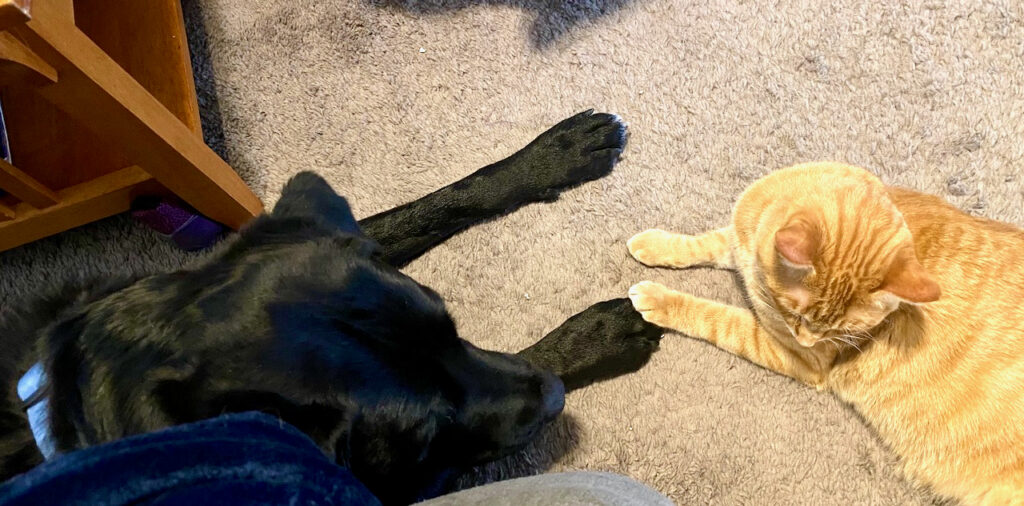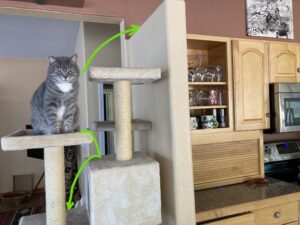
Although the expression “fight like cats and dogs” refers to people who are always arguing and fighting, cats and dogs can coexist in peace and harmony. A slow, gradual introduction provides a foundation for positive and predictable interactions between dogs and cats.
The owner’s role in introducing dogs and cats
Slow, Gradual Introduction – Off to a Good Start
It is wise to be pro-active when introducing dogs and cats. There are two styles of introductions (Reference 1):
Owner-led introductions
- Owner uses strategies that prevent dogs from being aroused around the cat.
- Strategies include distractions such as food treats and encouraging calm behavior.
Pet-led introductions
- Owners put the pets together expecting them to “work it out”.
- Behaviors indicative of stress in cats (aggression toward the dog, vocalization, hiding) are common.
- Risk of injury to either pet is more likely.
How to Lead when Introducing Dogs and Cats
Introducing dogs and cats is surprisingly similar to cat-cat introductions in terms of swapping scents, no visual contact initially, and supervised visits with a barrier in between. Experts recommend a multi-stage process rewarding both the cat and the dog for calm behavior (Reference 2):
Stage One – the New Pet Arrives
- Set up a dog zone and a cat zone before bringing the new pet home
- Allow the resident pet to become comfortable in his or her “zone”.
- “New” cats do better if confined to a small space initially (see Moving with Your Cat).
- Keep the dog and cat separate at first for a few weeks. Exchange bedding daily during that time so that each animal gets accustomed to the other’s scent.
It takes a dog about 3 weeks to destress and start settling into their new home and new routines (Reference 2).
Stage Two – Initial Visitations
- Have two people – one to manage the cat and one to manage the dog.
- Always use a barrier between the two pets.
- Don’t force the cat to come to the barrier – wait until he is resting somewhere you can bring the barrier and the dog to him.
- Consider using a free-standing accordion-style baby gate as a barrier.
- Allow the cat to leave the area if he/she desires.
- Have the dog on a leash.
- Reward calm behavior by both pets with tasty treats.
Stage Three – Intermediate Visitations
- Remove the dog’s lead and continue to use the barrier.
- Reward the dog and the cat for calm behavior.
Stage Four – Advanced
- Remove the barrier but keep the dog on a leash.
- Continue to reward both the cat and the dog for calm behavior.
- Gradually increase the duration of the face-to-face time as long as both pets are calm.
- Be sure to supervise the dog and cat when the leash is removed.
Always make sure the cat has escape routes to safe places – these can be high cat trees, cat flaps in doors to closets or other rooms, the tops of bookcases or high closet shelves (Space Cats Vertically).

Remember that it is natural for dogs to chase cats – buried under the layers of domestication is an animal that chased down small prey to eat and survive. It is also natural that cats will run when threatened by a large predator, trying to reach a safe zone, like a tree. In Owner-led introductions, the chase sequence is interrupted. These introductions tend to be more successful than pet-led introductions.
Rewarding calm behavior
When your dog first sees the cat, click (if using a clicker) or say “good” and see if he will take a treat. If he is whining, barking, stiff, tense or staring at the cat, walk him away from the barrier until you reach a distance where he is relaxed and calm. Reward him with a treat when calm.
Watch your cat for signs of stress – if she is crouched and slinking away, hissing, growling, try to lure her to a place where she is more comfortable, say a high cat tree, where she can observe the newcomer from a safe place. Reward with a high value treat.
Introducing dogs and cats can take weeks to months, depending on the pets. After your new dog or cat is settled in, you can start slow, gradual introduction. Be sure to monitor the pets’ body language and don’t hesitate to return to an earlier step if things are not going well.
A Useful Behavior
Dog owners will find it useful to teach their dogs to ignore food on the ground, other dogs, and small animals (such as cats). This is a useful behavior when introducing dogs and cats.
“Leave It!” is more than just having the dog ignore the food or other animal. One of the key points in this behavior is when the dog focuses his/her attention on you instead of the food or other animal. He is looking to you for guidance.
This behavior is trained in stages but usually starts as follows (Reference 3):
- Place a treat on the floor and put your hand over it.
- Have a higher value treat behind your back or in your pocket.
- Your dog will most likely try to get the treat, sniffing and pawing at your hand.
- Say “Leave It!”
- When she stops trying, click with a clicker or say “good”.
- Offer a higher value treat as she looks up at you.
This behavior can be generalized to include small animals, people or other dogs. In the case of introducing dogs and cats, you can use “Leave It!” to direct your dog’s attention away from the cat to yourself.
references
- Kinsman, R.H.; Owczarczak-Garstecka, S.C.; Casey, R.A.; Da Costa, R.E.P.; Tasker, S.; Murray, J.K. Introducing a Puppy to Existing Household Cat(s): Mixed Method Analysis. Animals 2022, 12, 2389. https://doi.org/10.3390/ani12182389
- Introducing Your New Dog to an Exisiting Cat. December 5, 2023. https://www.battersea.org.uk/pet-advice/dog-advice/introducing-your-new-dog-existing-cat. Viewed 4/2024
- Gibeault, Stephanie. “Leave It” Command: Training Your Dog to Ignore Food and Other Items. March 14, 2024. https://www.akc.org/expert-advice/training/learning-the-leave-it-command/. Viewed 4/2024.


